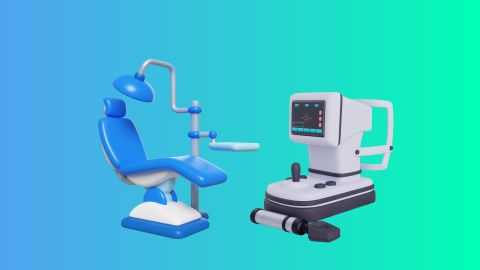If you work in surgical care, you likely understand the vital role anesthesia machines play in ensuring patient safety and comfort during procedures. These devices are essential for maintaining unconsciousness and pain-free states throughout surgery, but their capabilities go far beyond delivering anesthetic gases.
This guide explores the functionality of anesthesia machines, how they operate, and the factors that set different models apart. From vaporizers and monitoring systems to ventilators, we’ll highlight the key features to consider. You’ll also discover the range of options available in India, from basic models to advanced integrated workstations.
We provide practical tips for selecting the right machine based on your facility’s requirements, along with maintenance advice to ensure longevity. Concerned about costs? The guide includes typical pricing and financing options to help make your investment more feasible. Whether upgrading your OR or equipping a new clinic, this resource empowers you to make informed and confident decisions.
What is an anesthesia machine?
An anesthesia machine is a critical piece of medical equipment used in surgeries to administer anesthetics to patients, ensuring they remain unconscious and pain-free throughout the procedure. The machine allows precise control of oxygen, nitrous oxide, and other anesthetic gases, providing an essential role in both minor and major surgeries. Modern anesthesia machines are designed to offer safe, accurate, and reliable delivery of gases while ensuring patient safety during surgical interventions.
How does an anesthesia machine work?
An anesthesia machine works by delivering a controlled mixture of gases, including oxygen, nitrous oxide, and inhaled anesthetics, to the patient during surgery. Here's how it operates:
- Oxygen is supplied through the machine and delivered to the patient’s respiratory system.
- Anesthetic gases are vaporized and mixed with oxygen to create the desired concentration.
- The machine maintains a constant flow of gas to ensure the patient remains unconscious and pain-free.
- Monitoring systems keep track of the patient’s vitals, ensuring optimal oxygen levels and anesthesia concentration.
- The machine also provides mechanisms for ventilation, if required, for patients who are unable to breathe on their own.
In emergency and critical care settings, devices like medical ventilator machine are often used in conjunction to support patient respiration.
Components of an Anesthesia Machine
- Flowmeters: Regulate and measure the flow of gases like oxygen and nitrous oxide.
- Vaporizers: Convert liquid anesthetics into vapor and mix them with gases.
- Breathing Circuit: Delivers the anesthetic gas mixture to the patient and removes exhaled gases.
- Ventilator: Provides mechanical breathing support during surgery.
- Scavenging System: Collects and disposes of excess anesthetic gases safely.
- Monitoring Systems: Track vital parameters like oxygen levels, pressure, and carbon dioxide.
- Oxygen Supply: Ensures a continuous supply of oxygen to the patient.
- Backup Systems: Include manual resuscitation options in case of machine failure.
Types of anesthesia machines
Anesthesia machines come in various types, designed to meet the specific needs of different medical procedures. Key types include:
- Basic Anesthesia Machines: Simple, compact machines for low to moderate surgeries.
- Advanced Anesthesia Machines: Equipped with advanced monitoring systems, ideal for high-risk surgeries.
- Mobile Anesthesia Machines: Portable machines used in field surgeries or transport situations.
- Integrated Anesthesia Workstations: High-end machines with advanced features for intensive care settings and complex surgeries.
In addition to anesthesia units, hospitals often use high-efficiency equipment like a centrifuge machine for sample processing and fluid separation.
Key features of modern anesthesia machines
Modern anesthesia machines are equipped with several features to ensure safety, precision, and ease of use, including:
- Digital monitoring systems: Track vital signs like heart rate, oxygen saturation, and ventilation parameters.
- Precision flowmeters: Control the exact amount of gases being delivered to the patient.
- Vaporizer units: Accurately vaporize and mix anesthetic agents for precise administration.
- Ventilators: Provide mechanical ventilation for patients who cannot breathe on their own.
- Alarms and safety features: Alert the medical team in case of equipment malfunction or if the patient's vitals are outside safe ranges.
Facilities that rely on precision and miniaturized innovations often explore the integration of nano machines in diagnostic and therapeutic processes.
Applications of anesthesia machines
Anesthesia machines are used in various healthcare settings for different purposes, including:
- General surgery: Administering anesthesia during routine surgeries.
- Cardiac surgery: Critical for maintaining patient safety during heart surgeries.
- Orthopedic surgery: Ensures patients are unconscious and pain-free during bone and joint procedures.
- Pediatric surgery: Specialized anesthesia delivery for children during surgery.
- Emergency care: Used in resuscitation and emergency surgeries to manage breathing and anesthesia.
For patients with chronic kidney failure, surgical environments may also include devices like dialysis machines for continuous renal care during procedures.
Benefits of using anesthesia machines
Using an anesthesia machine provides several benefits, including:
- Safety: Ensures precise control of gas delivery, reducing the risk of overdose or underdose.
- Comfort: Allows for better control of anesthesia levels, leading to more comfortable recovery.
- Efficiency: Streamlines the process of anesthesia delivery, saving time during critical procedures.
- Patient monitoring: Provides real-time data on the patient’s vital signs, enhancing patient care.
- Customization: Offers flexible settings to cater to individual patient needs, including age and medical condition.
Price of anesthesia machine in India
The cost of anesthesia machines in India can vary depending on the type and features of the machine. Here's a basic breakdown:
| Type of Anesthesia Machine | Price Range (Rs.) |
| Basic Anesthesia Machine | 1,00,000 - 3,00,000 |
| Advanced Anesthesia Machine | 3,00,000 - 10,00,000 |
| Mobile Anesthesia Machine | 2,00,000 - 5,00,000 |
| Integrated Anesthesia Workstation | 8,00,000 - 20,00,000 |
Factors to consider when buying an anesthesia machine
When purchasing an anesthesia machine, consider the following factors:
- Type of surgery: Choose based on the level of complexity of the surgeries you perform.
- Monitoring systems: Look for machines with advanced monitoring features for better patient safety.
- Ventilation features: Ensure the machine provides adequate ventilation options for emergency scenarios.
- Space and portability: Consider whether a mobile or stationary machine is more suitable for your needs.
- Compliance with standards: Ensure the machine complies with national and international medical standards.
Investing in advanced anesthesia machines is crucial for seamless surgical care. A doctor loan can help you finance state-of-the-art equipment without upfront stress. Enjoy flexible repayment options and quick approval to focus on enhancing patient safety and outcomes. Check your eligibility now.
Maintenance tips for anesthesia machines
Maintaining an anesthesia machine is essential for ensuring its longevity and optimal performance. Follow these tips:
- Regular calibration: Ensure the machine is regularly calibrated to maintain accurate readings.
- Routine cleaning: Clean all components, including vaporizers and ventilation systems, to prevent contamination.
- Check gas flow and leak test: Regularly check the gas flow and perform leak tests to ensure safe operation.
- Monitor filters and components: Replace filters and other components as needed to maintain efficiency.
- Service and inspection: Schedule regular service and inspections with qualified technicians to address wear and tear.
Conclusion
An anesthesia machine is a critical piece of equipment for any surgical procedure, ensuring patient safety and comfort. The right machine can make a significant difference in the outcome of a surgery. If you’re looking to purchase one, it’s important to understand the various types, features, and prices in India, as well as the factors to consider for choosing the best one for your medical facility.
Additionally, securing finance for medical equipment can make the process smoother. You can explore the Medical Equipment Finance by Bajaj Finance, as well as options like a Doctor Loan or a Professional Loan, to help cover the cost of your purchase and ensure you have the best tools for patient care. Before applying, it’s advisable to check the detailed medical equipment finance eligibility criteria and required documents. You should also review the applicable medical equipment finance interest rate to plan your repayments confidently.




